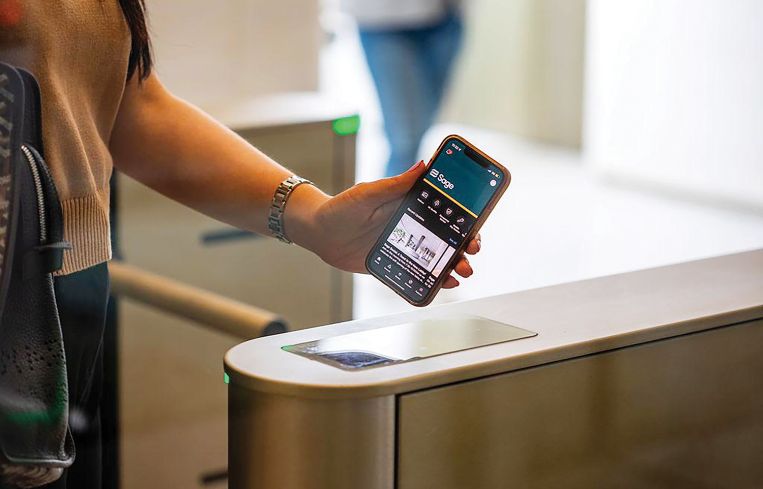Proptech Firms Ride Demand for Office Amenity Apps
This latest generation follows the original technological offerings from owners such as Tishman Speyer and brokerages like JLL
By Philip Russo May 7, 2024 9:30 am
reprints
There was a time before COVID when office landlords believed they could build their own tenant amenity technology and successfully compete for tenants. You know, build it and they will come.
Well, COVID and the work-from-home experience has forced such thinking to evolve, with proptech becoming more of a factor in the competition to lure occupiers and their workers back to the office.
While some office amenity platforms such as Tishman Speyer’s ZO have successfully navigated through from the pre-COVID days, some owners and proptech entrepreneurs are adjusting to the new realities of what it takes to bring occupiers back to the workplace.
Part of that adjustment has led to great growth for proptech startups such as HqO and VTS, both of which feature a platform for amenities along with a broader array of tenant experience services. But old school verities remain part of the story.
“Location is probably the biggest historical amenity that everyone would reference,” said Emily Fuller, global head of application services for RealFoundations, a Dallas-based professional services and consulting firm focused on the real estate industry. “There’s not a lot that you can do after you purchase the land, but location is definitely important.”
Building on that most basic of real estate assumptions, office owners are basing their amenity strategy on current tenant needs. “Pre-COVID, aside from general access and performance, you started to see more amenities focused on the space that was available in the building,” said Fuller. “So we started to see more flex space, more places that people could just pop into when they wanted to take a break from being in their office. It could be a gym or a coffee shop.”
During COVID, office landlords spent their dollars keeping tenants who actually did come to work shielded from the pandemic, she said. They accomplished this through technology-aided health, safety and occupancy monitoring, as well as air-quality testing and allowance for social distancing, she added.
“I think the biggest shift that we will see, and we are seeing, is amenities and the apps and things that need to be available and tracked in terms of ESG,” Fuller said, referencing the environmental, social and corporate governance standards embraced by many in real estate. “It’s something that people still love to think about. There’s a group of asset managers that are always asking how their buildings are performing. But, right now, the shift is really toward tenant experience. How can we match the tenant experience of being at home?”
The industry is selling experience, but it needs to track and monetize its investments in amenities to determine what actually brings a return on investment, she said.
“They’re selling a place where we can feel as productive as we felt while we were at home,” said Fuller. “And how do we do that? We bring things into the space that we would have had at our fingertips, whether it be dry cleaning, pet day care or a massage. We make it as easily accessible as possible. The owner operators, investors, and the property managers that embrace that should ideally see a larger return and the ability to draw tenants back into leasing that space.”
Hilo is a Toronto-based software startup that helps building operators attract office tenants, said David Abrams, its co-founder and CEO.
“Our focus on the end user is what differentiates us,” said Abrams. “The user is what drives the innovation around our technology. At the end of the day, we are measured on our ability to achieve very high levels of engagement. We will not be measured, ultimately, on how many operating systems are integrated into our platform. The question is how many people use it.”
Some owners have attempted to build digitized service offerings internally but have low tenant engagement rates, resulting in landlords re-evaluating and even abandoning their efforts, said Abrams. Other operators are working with proptech providers like Hilo, he added.

Montreal-based real estate investment, development and management company Canderel, which has created its own branded tenant experience platform called Okkto, is one such organization working with Hilo.
“They are committed to this new level of customer experience and service, helping to blur the boundaries between home life and work life,” said Abrams. “It is about creating an experience, and they’re using our technology to power it. That is the holy grail for a company like Hilo.”
Michael Spies, venture partner at proptech VC firm Navitas Capital, sees the office amenity technology landscape from another perspective, that of the differing needs of tenants looking for short-term versus long-term space.
“The most notable trend is the growing demand for shorter-term, flexible space,” said Spies, whose extensive real estate background includes being the former head of innovation at Tishman Speyer. “But it shouldn’t be viewed as existing to the exclusion of longer-term, more traditional spaces.”
Landlords and tenants share a desire to engage employees, which can lead to greater revenue for the former and better worker engagement and satisfaction for the latter, both highly valuable, he added.
“Personally, I don’t really like the ‘amenities’ term,” Spies said. “Amenities really are means to engage individuals in buildings. It’s not about amenities. It’s about what are the shared services that a landlord can provide for individual tenants, perhaps more efficiently than those that would provide them if each individual tenant went out and tried to procure those services individually.”
Spies sees the demand for shared services proptech coming pretty much equally from owners and tenants. “I think clearly these things are all converging, and the types of solutions that are emerging within proptech are much more holistically satisfying to the full array of needs that both landlords and tenants have. We’re seeing that convergence occur now.”
SwiftConnect, a Stamford, Conn.-based access control software and Navitas portfolio company, is an example of a proptech startup that appeals equally to landlords and occupiers, said Spies. “They’re probably out front in terms of serving the needs of both landlords and tenants in the area of access control.”
One large office real estate company that has created an in-house amenity platform, while also integrating proptech services, is Sage, a Manhattan-based real estate owner managing more than 3 million square feet of New York City office space. How an office owner goes about developing its amenity platform should depend on its investment thesis, said Jonathan Iger, Sage’s president and CEO.
“Are you a core holder, or are you more value-add or opportunistic on the office side?” said Iger. “I think, today, while more landlords are recognizing it, I think there’s a general bifurcation, whether they know it or not, about the approach to physically amenitizing properties. I always like to joke that real estate is not much different from the NFL in that we are a copycat league. So, if you see a building that used to get $70 rents and [it] is now getting $90 rents, and they put in these amenities, you simply equate that, but maybe you’re not looking at the other data points.
“The general approach is more than what’s the shiny object that’s currently working in the market to help lease up space. I’m going to throw in a gym and a wellness center and these different components without realizing or understanding what the market really wants out of it?”
Owners don’t want to load up tenants with so many underutilized amenities that they get hit with sticker shock once tenants realize the cost via rent, Iger said. “You have to make sure that the amenities that you’re providing are long-term, of value, and actually get used.”
To avoid such mistakes, Sage has worked with VTS, as well as with architectural firm Fogarty Finger to create Oasis, its amenity spaces across the company’s properties, said Iger. Together they have tried to balance Sage’s need to meet tenant amenity desires with its own requirement to monetize those spaces in a rational and coordinated manner.
“For us, the name of the game is retaining, but if Apple relied on what the customer wanted, none of us would ever have an iPhone in our pocket,” said Iger.
Speaking of Apple, Clelia Warburg Peters, managing partner at Era Ventures, a Manhattan-based proptech venture capital firm, also believes that office owners need to innovate their amenities in a similar way to retailers.
“The point of the Apple Store is not that you make a purchase,” Peters said, “but rather to allow people the experience of interacting with Apple,” adding that retailers embracing experiential spaces thrived while slow adapters died. “There may be lessons for property owners in that line of thinking.”
Philip Russo can be reached at prusso@commercialobserver.com.


